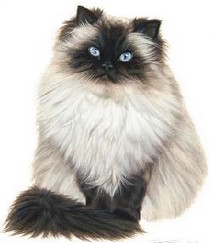


Himalayan Cat Breed: History, Temperament & Health Issues
History Of The Himalayan:
In the 1930's in the US, a black Persian was bred with a Siamese. The first generation consisted entirely of longhaired, black cats, but a pointed longhaired cat - the Himalayan - was produced when back-crossed. British efforts at creating a pointed Persian progressed through the 1930's and 1940's. The colorpoint Persian was accepted in 1955, and recognized of the Himalayan Persian was universal by 1961.
Common Himalayan Health Issues:
Epiphora (In modern type breed only): Relatives of the Persian and Himalayans are generally more prone to chronic eye irritations and infections that produce tearing and staining of the hair below the eyes. Antibiotics such as Tetracycline are usually prescribed. See cat eye health for more about eye disorders in cats.
Feline Hyperesthesia Syndrome: Extremely sensitive skin, it is similar to Psychogenic Alopecia in that it can be caused by stress. Treatment is also similar to Psychogenic Alopecia.
Psychogenic Alopecia: Abnormal hair loss that can be caused excessive self grooming. Similar to obsessive cumpulsive disorder in humans, Psychogenic Alopecia is caused by stress in your cat. This stress can be caused by other cats in the same house, people whom the cat dislikes, and/or separation anxiety. If your cat had an early history of abuse, he may also be prone to psychogenic alopecia. Treatment can include antidepressants, or simply separating the cat from its stressful environment. Or, you can attempt to enrich the cat's environment with toys, climbing equipment, providing a room with a view, even installing a fish tank. Be sure to determine first though, if your cat's alopecia is psychological and not caused by parasites, ringworm, pregnancy, or a hormonal imbalance.
In the 1930's in the US, a black Persian was bred with a Siamese. The first generation consisted entirely of longhaired, black cats, but a pointed longhaired cat - the Himalayan - was produced when back-crossed. British efforts at creating a pointed Persian progressed through the 1930's and 1940's. The colorpoint Persian was accepted in 1955, and recognized of the Himalayan Persian was universal by 1961.
Common Himalayan Health Issues:
Epiphora (In modern type breed only): Relatives of the Persian and Himalayans are generally more prone to chronic eye irritations and infections that produce tearing and staining of the hair below the eyes. Antibiotics such as Tetracycline are usually prescribed. See cat eye health for more about eye disorders in cats.
Feline Hyperesthesia Syndrome: Extremely sensitive skin, it is similar to Psychogenic Alopecia in that it can be caused by stress. Treatment is also similar to Psychogenic Alopecia.
Psychogenic Alopecia: Abnormal hair loss that can be caused excessive self grooming. Similar to obsessive cumpulsive disorder in humans, Psychogenic Alopecia is caused by stress in your cat. This stress can be caused by other cats in the same house, people whom the cat dislikes, and/or separation anxiety. If your cat had an early history of abuse, he may also be prone to psychogenic alopecia. Treatment can include antidepressants, or simply separating the cat from its stressful environment. Or, you can attempt to enrich the cat's environment with toys, climbing equipment, providing a room with a view, even installing a fish tank. Be sure to determine first though, if your cat's alopecia is psychological and not caused by parasites, ringworm, pregnancy, or a hormonal imbalance.
The Himalayan At A Glance:
Place Of Origin: Great Britain and United States
Dates Of Origin: 1950's
Average Weight Range: 8-15 lbs.
Temperament Of The Himalayan: Calm and Friendly
Breed Colors Of The Himalayan: A wide variety of self, tortie, and tabby points is acceptable.
Place Of Origin: Great Britain and United States
Dates Of Origin: 1950's
Average Weight Range: 8-15 lbs.
Temperament Of The Himalayan: Calm and Friendly
Breed Colors Of The Himalayan: A wide variety of self, tortie, and tabby points is acceptable.
Also known as the Himalayan Persian. This is possibly the first deliberate hybridization of two breeds. The Himalayan Persian features the first recognized "export" of the Siamese pointed pattern. Eye color is less intense than in the Siamese, and the pointing is softer in the longer coat. Himalayan Persians are outgoing but relaxed. The sexual precociousness of the Siamese can also manifest itself in these cats.
Sinus Conditions, Specifically Sinusitis: Infection of the frontal sinuses can occur with some frequency, as a secondary effect of a respiratory infection. Watch for a nasal discharge (often just on one side) accompanied by frequent sneezing and sniffling. Sinus issues are usually confirmed with an X-Ray showing increased density in the sinus(es), and are treated with an appropriate antibiotic. If this is not successful, a surgical procedure to make an opening into the sinus through the skin to aid in drainage may be required. See respiratory and sinus disorders for more information.
Pet Meds: Dogs | Pet Meds: Cats | Dog Health : By Breed | Cat Health : By Breed | Dog Grooming | Cat Grooming | Pet Top 10's | Pet Food Recipes
Pet Meds: Dogs Pet Meds: Cats Common Dog Health Issues Common Cat Health Issues Dog Grooming Cat Grooming Pet Top 10's
Pet Health:Home
Copyright 2006-2011 PetMedsOnline.Org
